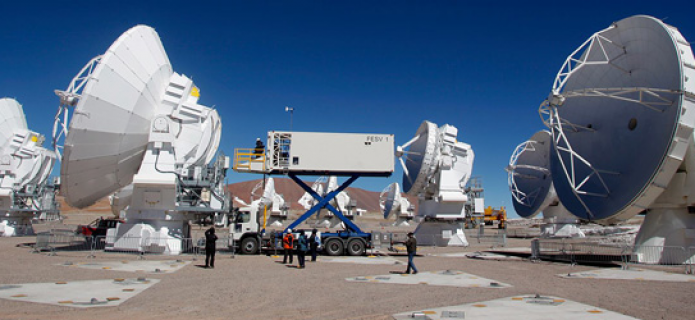Cryogenic Catering Truck Comes To The Alma Observatory
2 September, 2011 / Read time: 2 minutes
The ultimate in high altitude, high-tech catering has arrived in Chile to serve chilled “provisions” to the telescopes at the largest astronomical complex in the world, the Atacama Large Millimeter/submillimeter Array (ALMA).
Although it may look just like an airline catering truck, this vehicle is designed to carry something considerably more delicate than airplane meals! Each of the giant ALMA antennas contains a set of state-of-the-art, extremely sensitive superconducting receivers, or detectors, which are cryogenically cooled to –269 degrees Celsius (4 degrees above absolute zero). Until now, servicing these detectors has required moving the entire antenna, which weighs about 100 tons, from its observing site on the 5,000-meter Chajnantor plateau down to the support facility at 2,900 meters.
The newly arrived servicing truck, called the Front End Service Vehicle (FESV), is a custom designed truck packed with the equipment required to transport these delicate detector systems without having to move the entire antenna from the plateau. The truck moves its cargo cabin 6 meters vertically upwards, using a scissor lift, to align with the receiver cabin of an antenna, similar to catering trucks that align with aircraft doors, allowing personnel inside to replenish provisions directly at the airport gate.
“With the arrival of the FESV from our partners in Taiwan, we have delivered another critical element for the array, one that will reduce interruption to science, increase safety and efficiency of telescope maintenance, and reduce ALMA's carbon footprint”, said Dr. Mark McKinnon, North American ALMA Project Manager at the National Radio Astronomy Observatory (NRAO) headquarters in Charlottesville, Virginia.
Two FESVs were commissioned by the National Radio Astronomy Observatory, with the help of one of their partners in ALMA, the Academia Sinica Institute of Astronomy and Astrophysics. They were built by CoTech in association with Ke Chong Industries in Taiwan.
Upon completion, ALMA will be an 16-kilometer wide array of 66, ultra-precision millimeter-wave antennas built by ALMA's multinational partners from North America, East Asia, and Europe. These telescopes will work as one giant telescope to open a new window on celestial origins, capturing never-before seen details about the very first stars and galaxies in the Universe, probing the heart of our galaxy, and directly imaging the formation of planets.
